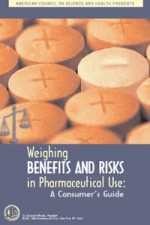 Our aversion to risk is particularly intense when it comes to prescription drugs.
Our aversion to risk is particularly intense when it comes to prescription drugs. Our aversion to risk is particularly intense when it comes to prescription drugs. The extravagant language used in newspaper headlines, examples of which will be discussed shortly, causes anxious patients to toss their pills away, so-called consumer advocates and government whistle-blowers to blast the drug manufacturers and the Food and Drug Administration (FDA) for malfeasance, and politicians to call for Congressional hearings. This scenario has been played out with increasing frequency in recent years, exacerbating consumers fears that the medicines they take may be unsafe. This sense of anxiety stems from a number of erroneous beliefs and misperceptions about the nature of risks and benefits in pharmaceutical science.
Our aversion to risk is particularly intense when it comes to prescription drugs. The extravagant language used in newspaper headlines, examples of which will be discussed shortly, causes anxious patients to toss their pills away, so-called consumer advocates and government whistle-blowers to blast the drug manufacturers and the Food and Drug Administration (FDA) for malfeasance, and politicians to call for Congressional hearings. This scenario has been played out with increasing frequency in recent years, exacerbating consumers fears that the medicines they take may be unsafe. This sense of anxiety stems from a number of erroneous beliefs and misperceptions about the nature of risks and benefits in pharmaceutical science.
This peer-reviewed publication of the American Council on Science and Health attempts to allay consumers' fears and help them make an informed decision about the risks and benefits of pharmaceutical drugs. While scientific and medical knowledge are not written in stone, and no treatment or technology can be absolutely safe, good information and open lines of communicationwith physicians and other trusted health providers can help to identify the relevant risks and benefits and enable patients to make the best health decisions.
Please also view our condensed version, What's the Story? Weighing the Benefits and Risks of Your Medications.
Weighing Benefits and Risks in Pharmaceutical Use: A Consumer's Guide


